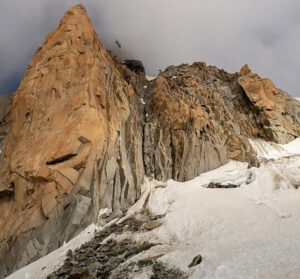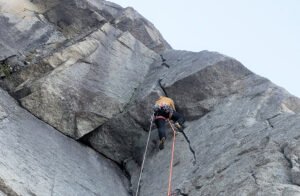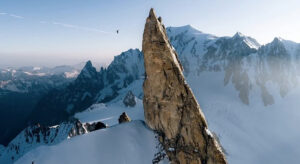He is still shaken after a very long fall he took ice climbing last weekend. His partner, Simon Messner, likewise got the fright of the season when Martin crashed to the ground on his side. But incredibly, Sieberer had only broken his helmet.
“How much luck does a climber need in life?” Messner wondered.
We asked Martin Sieberer about the incident and about his thoughts on ice climbing in general.
“I cannot exactly remember the fall, this stuff happens so fast,” Sieberer said. “I had a bad hook which slipped, then I fell and was hanging upside-down.”

Simon Messner at the beginning of the climb. Photo: Martin Sieberer
The pair were trying a project they had first envisioned some years ago, a beautiful mixed ice line.
“The rock was really bad,” Sieberer told ExplorersWeb. “It was quite warm, the mood was mystic, climbing in the fog. I was able to reach the first roof and put in some bombers. From there, I had to work my way up, half aiding, half climbing, but the protection was pretty bad. Nevertheless, I was really close to a safe point. Unfortunately, shortly before reaching it, I fell.”
The climbers follow a trad approach to opening the ice routes, meaning they place no bolts.
“On a first ascent, we try to put in removable gear (Friends, nuts, ice screws) but also pitons or slings, which we leave most of the time,” Sieberer noted.
About his fall, he admits, “I was not ready. It was my second ice climb in nearly two years, after I had a bad injury last year. I was too motivated, too impatient. And as we try to evolve and push the sport, it can be a thin line between safety and danger.”
Fascinated by the ephemeral

Negotiating a roof. Photo: Simon Messner
Sieberer also loves how transitory the sport is. It can only be practiced some months a year. And it’s always different.
“You never know how the season will be, how the ice will grow,,” he says. “You have to be patient.”
Many hard mixed climbs form only occasionally, and then never in the same way. “When they are good, you have to be ready,” he said, adding that bolting an ice route would destroy that fascination.
Do hard, long ice climbing routes help prepare him for Himalayan expeditions?
Ice climbing does force him to stay focused and determined, he admits, which is good preparation for high altitude. In the Himalaya, “so much of the time, you just have to be patient and be ready when the time is right,” he says.






